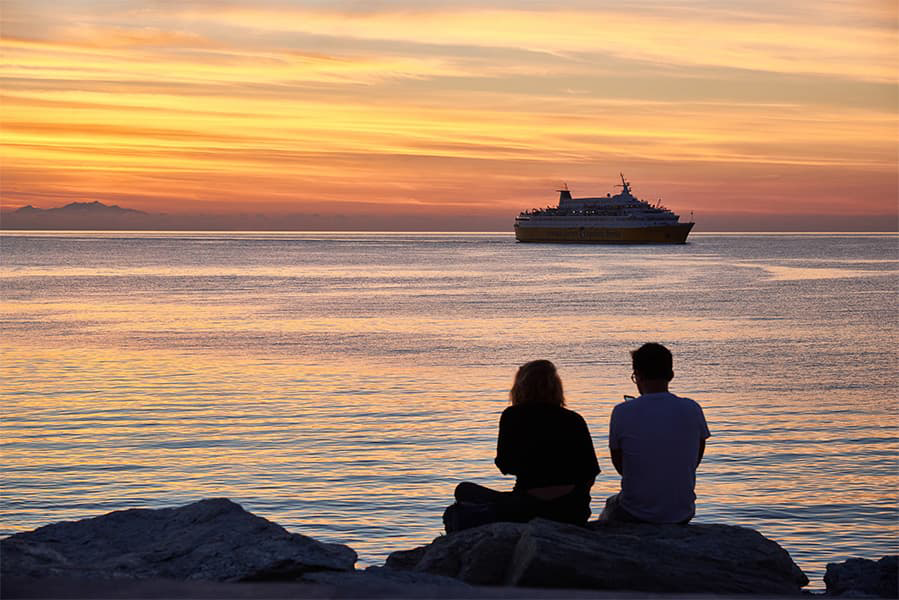Ferries from
Spain to Gran Canaria
Ferries from
Spain to Gran Canaria
Route
When do you want to travel?
Vehicle
Passengers


Ferries from Spain to Gran Canaria are available with 2 operators. There are 2 ferry routes. Ferries from Cadiz to Las Palmas and Huelva to Las Palmas are popular ferry trips from Spain to Gran Canaria. Sailing frequency can change throughout the year and often sailings increase during peak season.
Ferries from Spain to Gran Canaria sail approximately 3 times per week and are provided by Naviera Armas & Fred Olsen Express.
Spain to Gran Canaria ferry time ranges between 31 hours and 44 hours 30 minutes depending on the ferry route, operator, and ship.
The fastest ferry from Spain to Gran Canaria is in 31 hours on the Huelva to Las Palmas ferry with Fred Olsen Express.
Yes, you can travel on a car ferry from Spain to Gran Canaria with Naviera Armas & Fred Olsen Express.
The distance between Spain and Gran Canaria is 847 miles (1363km) and 736 nautical miles.
Spain to Gran Canaria ferry prices can vary by route, operator, season, vehicle type and whether you are sailing on a high-speed ferry or conventional ferry.
The Cadiz to Las Palmas ferry ferry sails approximately 2 times weekly with a crossing time of 35 hours 45 minutes.
Huelva to Las Palmas ferry ferries sail about 3 times weekly with a sailing time of 40 hours 30 minutes.
For the best ferry offers, we recommend booking in advance for the cheapest ferry prices and availability. Visit our special offers page to take advantage of all the latest ferry discounts.
Book and compare Spain Gran Canaria ferry tickets, operators, timetables and prices using our Deal Finder.
| From | To | Average price | |
|---|---|---|---|
From CadizSpain |
To Las PalmasGran Canaria |
Average price£512.22 | |
From HuelvaSpain |
To Las PalmasGran Canaria |
Average price£507.95 |
More routes than anyone else.

Compare fares, times & routes in one place.
Change plans easily with flexi tickets.

Book e-tickets & manage trips in-app.
Live ship tracking & real-time updates.

Top-rated customer support when you need it.
Yes, pets are allowed on certain routes, including Cadiz - Las Palmas and Huelva - Las Palmas. Operators that allow pets include Fred Olsen Express.
Pets are generally allowed, but will be kept in a designated pet-friendly area. Requirements may vary depending on the ferry operator. For travel from Spain to Gran Canaria, you may need vaccinations, pet passports, and a carrier.
Foot passengers on ferry routes from Spain to Gran Canaria generally have no strict luggage limit but are expected to handle their own bags. Vehicle passengers can usually bring belongings in their cars within reasonable limits.
Passengers can travel by direct ferry from Spain to Gran Canaria from popular ports like Cadiz and Huelva. Ferry routes offer convenient access to the island without the need for additional connections. View our Deal Finder for available ferry schedules and booking options.
Spain is a country located on the Iberian Peninsula and bordered by Portugal to the west, France to the north-east and the Mediterranean Sea to the South and East. The marvellous weather in Spain, its geographic location, beautiful coastlines and varied landscapes have made Spain one of the most popular holiday destinations in the world. Its capital city Madrid features winding streets all heading to gather in the centre of the city, Barcelona needs no introduction, the Basque country is to the North and then of course there’s the sunbathers mecca – the Costa del Sol. As a country with thousands of miles of coast and numerous island groups such as the Canaries and Balearic's, travelling by ferry is deeply rooted into Spanish culture. Europe’s most modern ferries and well-known ferry companies are in operation providing services from Spain to the UK, Italy and North Africa as well as crossing from the mainland to the Canary Islands, the Balearic Islands and numerous inter island connections.
Gran Canaria is the second most populous island in the Canary Islands, a Spanish archipelago in the Atlantic Ocean. A ‘continent in miniature’, Gran Canaria is locally known. This is due to the huge variety of landscapes and micro-climates, with vast mountains, long beaches and green ravines all coming together on this 1,500 square-kilometre landmass. A third of Gran Canaria is classified as a UNESCO Biosphere Reserve, but elsewhere, you will find a rich history in the cosmopolitan capital of Las Palmas, a charming hilltop village in Tejeda and a network of superb cycling routes winding through the valleys. Travelling by ferry is a convenient way to explore the Canaries, and, given Gran Canaria’s central location, it’s within easy reach from nearly every other island. There are also some long-distance connections from mainland Spain which are operated by a couple of excellent ferry companies.